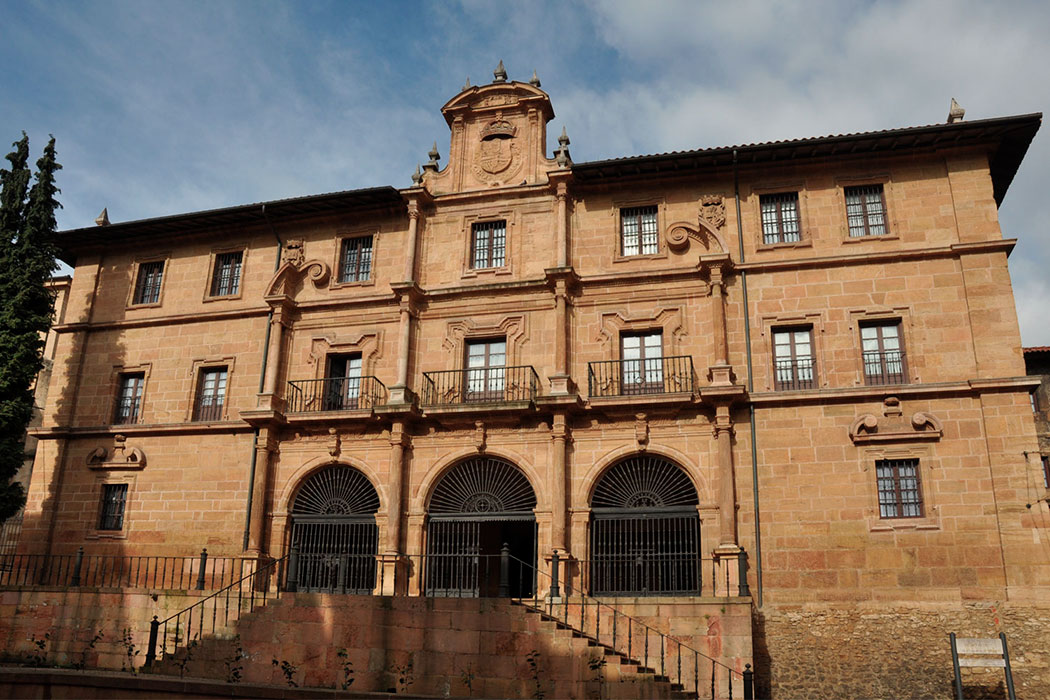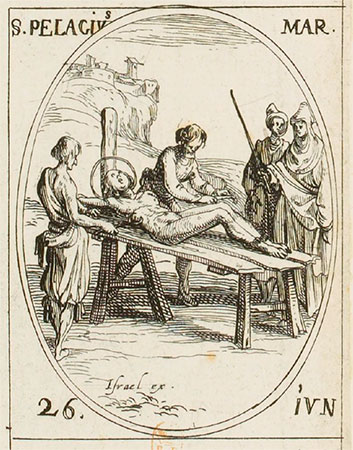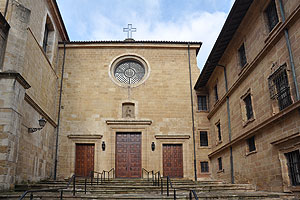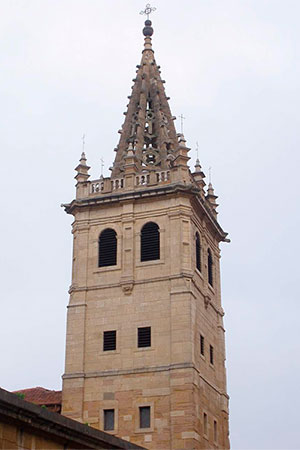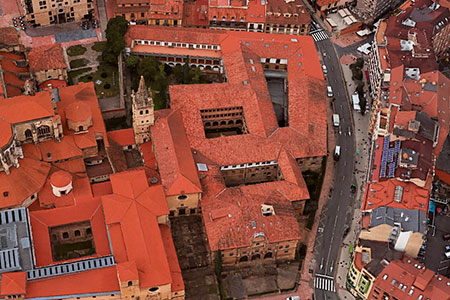Monastery of San Pelayo de Oviedo
Monasterio de San Pelayo / Las Pelayas / San Juan y San Pelayo
(Oviedo / Uviéu, Asturias)
Traditionally, it has been accepted that this monastery was founded by Alfonso II of Asturias (c. 762-842) as a place of retreat for his sister Jimena, who is also considered its first abbess. On the other hand, this monastery was initially known under the dedication of Saint John the Baptist. In 988, due to an attack by Almanzor that affected León, the relics of Saint Pelagius, which were kept in that city, were transferred to this monastery of San Juan Bautista in Oviedo, where they were safeguarded.
In 996, Teresa Ansúrez († 997), wife of Sancho I the Fat († 965), was documented as the head of the Oviedo monastery, which suggests that this community, possibly from León, may have moved to Oviedo due to the Moorish attack and that it later continued at the monastery of San Isidoro de León. From that time on, the Oviedo monastery was known under the dedication of San Juan Bautista y San Pelayo. However, the lack of documentation does not allow for confirming the veracity of this account.
In 996, Bermudo II of León made a donation to the monastery of San Juan y San Pelayo, confirming its existence at that time. At that point, the monastery welcomed daughters of royalty and nobility and was connected to the nearby male monastery of San Vicente and the basilica and cathedral of San Salvador. In 1053, the monastery received a significant boost with the visit of Fernando I of León, who, on that occasion, lavishly endowed it, and the renovation of the monastic buildings began. During the 12th century, the nuns officially adopted the Rule of Saint Benedict (1152), and at the same time, the dedication to Saint John the Baptist was lost, leaving only that of Saint Pelagius.
Thanks to royal protection, the monastery gained great notoriety, wealth, and power. The nuns who were part of the community, due to their high social status, also contributed to this. Donations, especially from the court, continued to flow in, and the monastery accumulated a significant seigniorial domain. This prosperity, however, harmed the Benedictine spirit, which led to concerns from the bishopric of Oviedo. In 1379, measures were taken to address this situation. At the beginning of the 16th century, the monastery became part of the Congregation of San Benito of Valladolid.
In the mid-16th century, San Pelayo welcomed other Benedictine communities that were concentrated there: Santa María de la Vega, Santa María de Villamayor, and San Bartolomé de la Nava. By the end of the 16th century, the monastery's favourable economic situation allowed for the reconstruction of the church and other buildings. By the 19th century, the monastery suffered from the effects of the Peninsular War, with a temporary exclaustration, and in 1837, the confiscation of church property deprived the community of much of its wealth. The 1934 Revolution and the Spanish Civil War deeply disrupted the establishment until the community was able to return in 1939. Today, the monastery from the Baroque period (16th-18th centuries) is preserved, housing some remains of the original medieval buildings (10th-12th centuries).
- CAYROL BERNARDO, Laura (2013). El monasterio de San Pelayo de Oviedo: infantado y memoria regia. Territorio, sociedad y poder, núm 8
- CERRA, Silverio; i altres (1994). Real Monasterio de San Pelayo. Oviedo: Monjas Benedictinas
- COLOMBÁS, García M. (1982). San Pelayo de León y Santa María de Carbajal. Biografía de una comunidad femenina. León: Monasterio de Carbajal
- FERNÁNDEZ CONDE, Francisco Javier; i altres (2007). Los orígenes del monasterio de San Pelayo (Oviedo): aristocracia, poder y monacato. Territorio, sociedad y poder, núm. 2
- GARCÍA ÁLVAREZ-BUSTO, Alejandro; ed. (2020). Asturias monástica. Catálogo de monasterios y revisión histórica arqueológica (siglos XI-XIX). Vol. 1. Anejos de Nailos n.º 7. Ovedo: KRK Ed.
- GARCÍA GUINEA, Miguel Ángel; dir. (2006). Enciclopedia del Románico en Asturias. Aguilar de Campoo. Fundación Santa María la Real
- MARTÍNEZ VEGA, Andrés (2011). Monasterios medievales de Asturias. Oviedo: Cajastur, 2011
- SITGES, Juan B. (1913). El Monasterio de Religiosas Benedictinas de San Pelayo el Real de Oviedo. Madrid: Rivadeneyra
- TORRENTE, Isabel (1994). Abadologio del Monasterio de San Pelayo de Oviedo (siglos X-XV). Asturiensia medievalia, núm. 7
- TORRENTE, Isabel (1996). Familia monástica del Monasterio de San Pelayo de Oviedo (s. X-XII). Asturiensia medievalia, ISSN 0301-889X, núm. 8
- Link ↗ : Monasterio de San Pelayo
